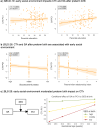Heterogeneous, temporally consistent, and plastic brain development after preterm birth
- PMID: 40940320
- PMCID: PMC12432136
- DOI: 10.1038/s41467-025-63967-1
Heterogeneous, temporally consistent, and plastic brain development after preterm birth
Abstract
The current view of neurodevelopment after preterm birth presents a strong paradox: diverse neurocognitive outcomes suggest heterogeneous neurodevelopment, yet numerous brain imaging studies focusing on average dysmaturation imply largely uniform aberrations across individuals. Here we show both, spatially heterogeneous individual brain abnormality patterns but with consistent underlying biological mechanisms of injury and plasticity. Using cross-sectional structural magnetic resonance imaging data from preterm neonates and longitudinal data from preterm children and adults in a normative reference framework, we demonstrate that brain development after preterm birth is highly heterogeneous in both severity and patterns of deviations. Individual brain abnormality patterns are also consistent for their extent and location along the life course, associated with glial cell underpinnings, and plastic for influences of the early social environment. Our findings extend conventional views of preterm neurodevelopment, revealing a nuanced landscape of individual variation, with consistent commonalities between subjects. This integrated perspective implies more targeted theranostic intervention strategies, specifically integrating brain charts and imaging at birth, as well as social interventions during early development.
© 2025. The Author(s).
Conflict of interest statement
Competing interests: The authors declare the following financial interests/personal relationships which may be considered as potential competing interests: M.T. and J. Schulz reports financial support was provided by the German Academic Scholarship Foundation (“Studienstiftung des deutschen Volkes”). C.S., A.M., and D.M.H. report financial support was provided by the German Research Foundation (“Deutsche Forschungsgemeinschaft”; DFG). P.B., D.W., and C.S. report financial support was provided by German Federal Ministry of Education and Science. D.W. and P.B. report financial support was provided by EU Horizon 2020. C.S., D.M.H., and B.S.-K. report financial support was provided by Commission for Clinical Research, Technical University of Munich. Data collection for the Bavarian Longitudinal Study from birth to 26 years was supported by grants from the German Federal Ministry of Education and Science (BMBF). D.W. and data collection of BLS at age 38 years are supported by the UK Research and Innovation (UKRI) Research Frontier Grant under the UK governments Horizon Europe funding guarantee. J. Seidlitz, R.A.I.B., and A.A.-B. hold equity in and J. Seidlitz and R.A.I.B. are directors of Centile Bioscience. Other authors have no known competing financial interests or personal relationships that could have appeared to influence the work reported in this paper.
Figures










References
-
- WHO WHO: recommended definitions, terminology and format for statistical tables related to the perinatal period and use of a new certificate for cause of perinatal deaths. Modifications recommended by FIGO as amended October 14, 1976. Acta Obstet. Gynecol. Scand.56, 247–253 (1977). - PubMed
-
- UNICEF, WHO, World Bank Group & United Nations. UN Inter-Agency Group for Child Mortality Estimation. Levels and Trends in Child Mortality: Report 2017. (United Nations Children’s Fund, New York, 2017).
-
- Johnson, S. & Marlow, N. Early and long-term outcome of infants born extremely preterm. Arch. Dis. Child102, 97–102 (2017). - PubMed
-
- Wolke, D., Johnson, S. & Mendonça, M. The Life Course Consequences of Very Preterm Birth. Annu Rev. Dev. Psychol.1, 69–92 (2019).
MeSH terms
Grants and funding
- U01 DA051039/DA/NIDA NIH HHS/United States
- U01 DA041120/DA/NIDA NIH HHS/United States
- U01 DA051018/DA/NIDA NIH HHS/United States
- U01 DA041093/DA/NIDA NIH HHS/United States
- K08 MH120564/MH/NIMH NIH HHS/United States
- U24 DA041123/DA/NIDA NIH HHS/United States
- R33 DA027644/DA/NIDA NIH HHS/United States
- U01 DA051037/DA/NIDA NIH HHS/United States
- U01 DA051016/DA/NIDA NIH HHS/United States
- U01 DA041106/DA/NIDA NIH HHS/United States
- U01 DA041117/DA/NIDA NIH HHS/United States
- U01 DA041148/DA/NIDA NIH HHS/United States
- WT_/Wellcome Trust/United Kingdom
- U01 DA041174/DA/NIDA NIH HHS/United States
- U24 DA041147/DA/NIDA NIH HHS/United States
- T32 MH019112/MH/NIMH NIH HHS/United States
- U01 DA051038/DA/NIDA NIH HHS/United States
- SO 1336/1-1/Deutsche Forschungsgemeinschaft (German Research Foundation)
- U01 DA041134/DA/NIDA NIH HHS/United States
- U01 DA041022/DA/NIDA NIH HHS/United States
- U01 DA041156/DA/NIDA NIH HHS/United States
- U01 DA050987/DA/NIDA NIH HHS/United States
- U01 DA041025/DA/NIDA NIH HHS/United States
- U01 DA050989/DA/NIDA NIH HHS/United States
- U54 MH091657/MH/NIMH NIH HHS/United States
- U01 DA041089/DA/NIDA NIH HHS/United States
- U01 DA050988/DA/NIDA NIH HHS/United States
- U01 DA041028/DA/NIDA NIH HHS/United States
- U01 DA041048/DA/NIDA NIH HHS/United States
LinkOut - more resources
Full Text Sources

